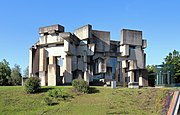Wotruba Church: Difference between revisions
No edit summary |
Chaotic Enby (talk | contribs) Fixed gallery |
||
| (One intermediate revision by one other user not shown) | |||
| Line 16: | Line 16: | ||
The '''Kirche Zur Heiligsten Dreifaltigkeit''' ({{lang-en|Church of the Most Holy Trinity}}), better known as the '''Wotrubakirche''' or '''Wotruba Church''', is a [[Catholic Church|Catholic]] church located in [[Liesing]], [[Vienna]]. It was built between August 1974 and October 1976, based on a design by Austrian sculptor [[Fritz Wotruba]].<ref>{{Cite web |title=The Wotruba Church |url=https://www.virc.at/unit/virc/en/sightseeings/places/article/90816.html |access-date=2023-11-12 |website=Katholische Kirche - Erzdiözese Wien - Kategoriale Seelsorge |language=en}}</ref> |
The '''Kirche Zur Heiligsten Dreifaltigkeit''' ({{lang-en|Church of the Most Holy Trinity}}), better known as the '''Wotrubakirche''' or '''Wotruba Church''', is a [[Catholic Church|Catholic]] church located in [[Liesing]], [[Vienna]]. It was built between August 1974 and October 1976, based on a design by Austrian sculptor [[Fritz Wotruba]].<ref>{{Cite web |title=The Wotruba Church |url=https://www.virc.at/unit/virc/en/sightseeings/places/article/90816.html |access-date=2023-11-12 |website=Katholische Kirche - Erzdiözese Wien - Kategoriale Seelsorge |language=en}}</ref> |
||
The building of the church was initiated by |
The building of the church was initiated by {{Interlanguage link|Margarethe Ottillinger|de|Margarethe Ottillinger}}, and designed by Wotruba. The planning architect was {{Interlanguage link|Fritz Gerhard Mayr|de|Fritz Gerhard Mayr}}. Ottillinger chose the site of former [[Nazi Austria|Nazi]] barracks, and wanted the new church to make a bold religious and artistic statement during a time of increasing [[secularization]]. Wotruba died before the completion of the church, and Mayr oversaw the remaining work.<ref name=":0">{{Cite web |date=2018-02-13 |title=The Bizarre Brutalist Church that Is More Art than Architecture |url=https://www.archdaily.com/886994/the-bizarre-brutalist-church-that-is-more-art-than-architecture |access-date=2023-11-12 |website=ArchDaily |language=en-US}}</ref> |
||
Wotruba's church was inspired by [[Chartres Cathedral]],<ref name=":0" /> and built in a [[Brutalist architecture|Brutalist]] style. Built of 152 concrete blocks, it has no visible symmetry, and makes use of clear glass windows to provide light. The [[Altar (Catholic Church)|altar]] is made of artificial marble. The bronze [[crucifix]] is a copy of one that Wotruba designed for the hofkirche in [[Bruchsal]], Germany.<ref>{{Cite web |title=Wotruba Church |url=https://architectuul.com/architecture/wotruba-church |access-date=2023-11-12 |website=Architectuul}}</ref> |
Wotruba's church was inspired by [[Chartres Cathedral]],<ref name=":0" /> and built in a [[Brutalist architecture|Brutalist]] style. Built of 152 concrete blocks, it has no visible symmetry, and makes use of clear glass windows to provide light. The [[Altar (Catholic Church)|altar]] is made of artificial marble. The bronze [[crucifix]] is a copy of one that Wotruba designed for the hofkirche in [[Bruchsal]], Germany.<ref>{{Cite web |title=Wotruba Church |url=https://architectuul.com/architecture/wotruba-church |access-date=2023-11-12 |website=Architectuul}}</ref> |
||
{{Gallery |
|||
|title=Gallery |
|||
| ⚫ | |||
File:Wien - Wotrubakirche ( |
|File:Wien - Wotrubakirche (4).JPG|Exterior view from the south |
||
File:Wien - Wotrubakirche |
|File:Wien - Wotrubakirche (5b).JPG|Exterior view from the north |
||
| ⚫ | |||
</gallery> |
|||
}} |
|||
== References == |
== References == |
||
Latest revision as of 00:44, 18 February 2024
| Wotruba Church | |
|---|---|
Wotrubakirche | |
 | |
 | |
| Location | Mauer District, Liesing, Vienna |
| Country | Austria |
| Denomination | Catholic Church |
| Architecture | |
| Architect(s) | Fritz Wotruba, Fritz Gerhard Mayr |
| Style | Brutalism |
| Groundbreaking | 1974 |
| Completed | 1976 |
| Administration | |
| Archdiocese | Vienna |
The Kirche Zur Heiligsten Dreifaltigkeit (English: Church of the Most Holy Trinity), better known as the Wotrubakirche or Wotruba Church, is a Catholic church located in Liesing, Vienna. It was built between August 1974 and October 1976, based on a design by Austrian sculptor Fritz Wotruba.[1]
The building of the church was initiated by Margarethe Ottillinger, and designed by Wotruba. The planning architect was Fritz Gerhard Mayr. Ottillinger chose the site of former Nazi barracks, and wanted the new church to make a bold religious and artistic statement during a time of increasing secularization. Wotruba died before the completion of the church, and Mayr oversaw the remaining work.[2]
Wotruba's church was inspired by Chartres Cathedral,[2] and built in a Brutalist style. Built of 152 concrete blocks, it has no visible symmetry, and makes use of clear glass windows to provide light. The altar is made of artificial marble. The bronze crucifix is a copy of one that Wotruba designed for the hofkirche in Bruchsal, Germany.[3]
References
[edit]- ^ "The Wotruba Church". Katholische Kirche - Erzdiözese Wien - Kategoriale Seelsorge. Retrieved 2023-11-12.
- ^ a b "The Bizarre Brutalist Church that Is More Art than Architecture". ArchDaily. 2018-02-13. Retrieved 2023-11-12.
- ^ "Wotruba Church". Architectuul. Retrieved 2023-11-12.



